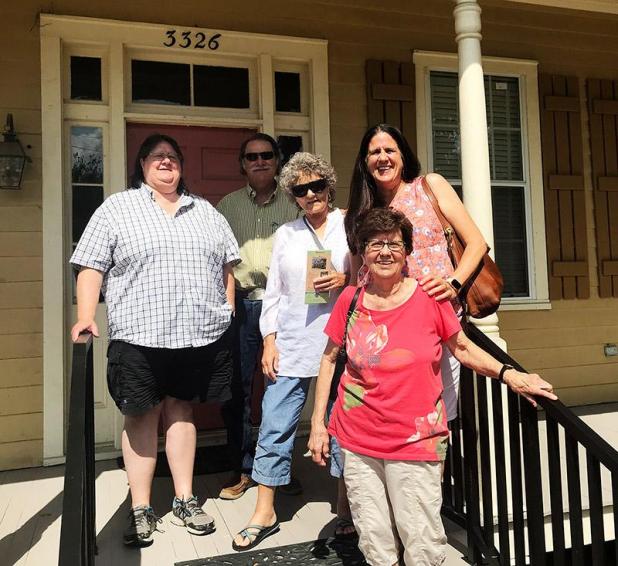
(Submitted Photo/The Brown House
Carol Jean King Vorhees and family members stand on the front steps of Vorhees’ former home, the Brown House. Vorhees is on the front row, while on the second row, from left, are her daughter, Jacqueline Masingale of Clarkston, Washington; Penny Brown Bell of St. Francisville, Vorhees’ first cousin; and Rebekah Spurrier, Vorhees’ daughter from Tuscaloosa, Alabama. Bell is the granddaughter of Theresia Thorguson Brown, for whom the house was built. On the back row is Edward Bell of St. Francisville.
The story of a town and a family: Berwick's Brown House
For the Berwick Historical Society, the Brown House is a museum gathering the history of the town.
For Carol Jean King Vorhees, the house represents home.
Carol lived in the home for a period of time as a child, returned often to visit family there and most recently returned from her home in Kansas to visit about two weeks ago with family.
She had been multiple times before, but her most recent visit was her first time to see the work that had been done to make the home a museum of Berwick history.
“My daughters and I were both very, very pleased,” Carol said. “I think they’re doing a tremendous job, and I certainly give them my approval and support.”
As a child, Carol lived in the home with her family while her father, the Rev. Fred King, was pastor at First United Methodist Church of Berwick.
Her great-grandfather, Gunder Thorguson, built the home in 1893 for his daughter, Thresia Thorguson Brown, when she married George Humphrey Brown.
“Part of the deal was he come with the house,” Berwick Historical Society archivist/historian Shannon McFate said, noting Thorguson died at the home.
One of Thresia’s sons, George Dewey Brown, and his wife, Wilhelmina “Billie” Diboll Brown, lived there with his mother. They later were joined by the King family, which included Carol. Her father had married Thresia’s lone daughter, Henrietta, and the family lived there during his pastoral assignment in Berwick.
While Carol left Berwick when she was about 10 years old due to her father taking another pastoral assignment, she would return during summertime for about a month during her elementary and junior high years.
“So I could play with my friends and be with grandmother,” she said.
Through the years, Carol and her family visited the home while Dewey and Billie lived there. Dewey and Billie had no children and therefore donated the home to the town for a museum upon their death.
Berwick Historical Society treasurer and researcher Toni Fangue said the society was founded and received town council approval to use the home as a museum and archives.
Now, it is the home to an exhibit on live oak trees in Berwick in one room, while another features history of the town.
A third room has an Orphan Train exhibit with biographical details of those who were adopted by Berwick families. The garments and shoes of one of those adopted are displayed in the home. The home also features a Hall of Valor where the names of military personnel are displayed as well as two military uniforms.
Fangue and McFate asked those with any information about the history of Berwick, including stories, documents or photos that could be donated to the museum or taken on loan, to contact the Berwick Historical Society.
McFate also asked for those who are veterans from Berwick to contact the historical society. The society can be reached through the Brown House’s Facebook page, or Fangue and McFate can be reached through the town of Berwick at 985-384-8858 or brownhouse@townofberwick.org.
The museum is open 10 a.m.-3 p.m. Monday and Wednesday and 10 a.m.-2 p.m. Saturday. Appo-intments also can be made to tour the museum. Admission is free.
While the home is now a museum, Carol recalled memories of her time there as a child.
“Well, the first thing I said when I walked in the doors and saw the stairs was, ‘Oh my, I’ve played (with) a lot of paper dolls on those steps,’” she said of the staircase facing the home’s entrance.
She also recalled playing hopscotch often on the sidewalk outside the home when it was on Second Street. The home was moved to its current location on Third Street with the construction of the E.J. Lionel Grizzaffi U.S. 90 bridge.
Carol has an older brother, now in his 90s, who lives in Indianapolis. She said he came about 10 years ago to see the home, but he didn’t make this trip. But she said she has talked to him about the work, and he is happy to see what has been done.
For those working with the museum, even hosting Carol and her family in her former home for hours wasn’t enough.
“We didn’t want them to leave,” Fangue said.
